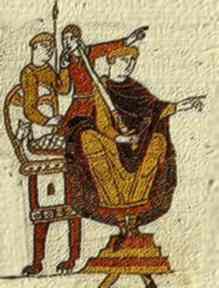
The Norman Conquest
On the death of King Edward, Harold Godwinson was crowned King of England on 6th January 1066 at Westminster Abbey, but the right to sit on the throne of England was contested as there were others who claimed they should have been coroneted instead, King Harald Hardrada of Norway, two English claimants, and King Harold’s brother Tostig, who had been banished from England in 1051, and also William the Duke of Normandy,
William Duke of Normandy, aka ‘William the Bastard’ later after the conquest of England he would be known as ‘William the Conqueror’, claimed that the throne of England should be his, and claimed Harold as a ‘usurper’. Harold anticipated William would attack England, and prepared to repel the Norman invasion.
The army of King Harald of Norway and took York, after a peaceful surrender the local inhabitants agreed to gather supplies at Stamford Bridge. King Harold left the south and marched north with his army on 25th September 1066 to York. surprised his brother Tostig and about 6,000 of his men, and a long battle ensued in which the Norwegians suffered a complete and utter defeat. Tostig was killed in the battle, along with Harald Hardrada. 11,000 men defended the Norse ships but fewer than twenty of the three hundred Norwegian ships returned home.
On 27 September 1066, William’s fleet set sail, landing near Pevensey Bay, Sussex on 28 September. William then moved a few miles to the east, where he built a fortified base near the coast, for his line of communications with Normandy, - and waited for Harold's return from the north.
Harold, left much of his forces in the north, and marched his army south to deal with the threatened Norman invasion. Harold stopped in London, and was there for about a week before marching to Hastings. Harold attempted to surprise the Normans, but was found out by William's scouts which proceeded to develop into a battle. William left his motte-and-bailey castle with his army and advanced towards Harold who had taken a defensive position at the top of Senlac Hill, about 6 miles from William's castle at Hastings.
What is referred to as “The Battle of Hastings”, began at about 9am and lasted all day, William used both cavalry and infantry, including archers against Harold who had formed up as a shield wall along the ridge's border, and were at first was so effective that William's army was thrown back with heavy casualties. Some of the English troops appear to have pursued the fleeing Bretons. However, Norman cavalry then attacked the pursuing troops and killed them. Twice more the Normans feigned flight and drew the English into pursuing them on foot, allowing the Norman cavalry to attack them repeatedly. In the afternoon Harold was killed, some reports claim that he was killed by William, another version as might be shown on the Bayeux Tapestry, Harold’s death was by an arrow to the eye, or perhaps Harold was the one shown slain on the ground.
The Norman Conquest of England is depicted in the Bayeux Tapestry which is not a 'tapestry', but an embroidered cloth 230 feet long, possibly commissioned in England. The tapestry can be seen in the Musée de la Tapisserie de Bayeux, in Bayeux, Normandy.
